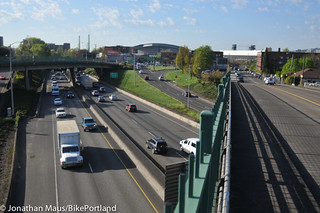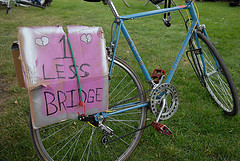The Columbia River Crossing highway-rail expansion project died with a whimper two weeks ago, and Portland’s low-car transportation advocates have just started to rub their eyes and organize their celebrations.
With this big project in the rear-view, we want to ask the BikePortland community what the Portland region has learned.
To inspire your thoughts (and further actions) here’s a roundup of some ways the Portland area is adjusting to a post-CRC reality:
Celebrations: The meme factory workers at OMG CRC WTF are organizing a celebration July 22 at Velo Cult to recognize the victory and talk about what’s next. There’s also what looks like quite a crowded happy hour this Friday at Produce Row.
Ministry of truth: Anti-CRC activist Dan Kaufman has made an interesting list of myths he says can be busted, now that project planners are no longer being paid to push them (links below are my own):
- The I-5 bridge is in immediate need of replacement. ODOT documentation from 2005 states that with proper maintenance the I-5 bridge has another 50-60 years of life.
- I-5 must be widened through Portland. Urban freeways are on the way out. Portland already has given up too much valuable real estate for passersby.
- Vancouver residents want light rail. Actually, they might take it if it were free, but they have not yet been offered a project they are willing to fund.
- Seismic issues are our most pressing transportation safety and infrastructure concern. With daily automobile-induced carnage and congestion, they are simply not.
- Most of the project cost was the bridge or the light rail. Actually the largest cost was the new freeway interchanges.
- The CRC was an economic benefit as a works project. Any short-term jobs benefit was outweighed by the loss of permanent (and potential) jobs near the project site and upriver. If we are looking for a WPA project, we can do a lot better and not put the tab on the backs of working-class commuters.
- The new bridge was an improvement for cyclists and pedestrians. If you think passage similar to I-205 is an improvement, perhaps, but not when you consider that they cut a significant portion of the bike/ped access over North Portland Harbor.
Back to business: The Columbian business section’s retrospective on the end of the project includes this from downtown Vancouver real estate owner Craig Angelo: For better or worse, downtown Vancouver is now no longer waiting for a $3 billion shadow to drop over it. “Every individual and business that was waiting for a decision on the new bridge now knows their fate. They should sit back, take a deep breath and plan accordingly to resume their lives.”
Will the next CRC be better? On Portland Transport, Scott Johnson says government officials and the public in general are moving away from two key forces behind highway projects: suburbanization and trade unions.

is now the only major active highway expansion project
in Portland.
How will this affect ODOT’s Rose Quarter plans? On Blue Oregon, Chris Smith wonders if Oregon’s transportation department could redirect bonding capacity intended for the CRC to instead pay for highway expansion near the Rose Quarter. But for all its problems, the bill authorizing Oregon’s borrowing for the CRC was very explicit that the money could only be used for that project, and only if the State of Washington acted to fund it. However, it’s definitely the right time to ask whether the Rose Quarter plans need a re-grounding in political reality.
Have engineering firms marginalized themselves? When we reported yesterday on the creation of a new regional transit advocacy group, several readers immediately pointed out, correctly, that its founder’s current and past employer stood to get big benefits from the CRC. (Another reader noted that the group also has tentative support from one of the CRC’s most vocal opponents.) Has the long fight over this project done permanent damage to the companies involved with it?
What role did urbanists play? Here’s a question I haven’t seen asked yet. Because it was a near-party-line vote by Washington Senate Republicans that finally killed the CRC, many people are saying that conservatives killed the CRC singlehandedly. I’m not so sure. In retrospect, although Metro President David Bragdon and Portland Mayor Sam Adams signed off on the compromise project in 2010, the price they exacted for their signatures (tolling and light rail) were exactly the terms that ended up alienating Washington conservatives. No, Bragdon and Adams didn’t walk away from this project when they could have. But anti-highway pressure from their constituents forced them to take positions that turned out to be poison pills.
In memoriam: Columbian reporter Eric Florip wrote an obituary for the project: “In 2008, the CRC wedded light rail in an arranged marriage. The two remained committed to each other until the end, but never took their planned honeymoon to Clark College.” The newspaper even put together a video to mark the occasion:
We’d love to see some further funeral orations below.


